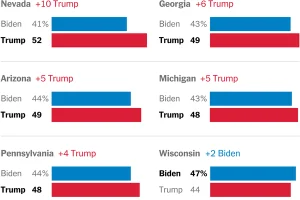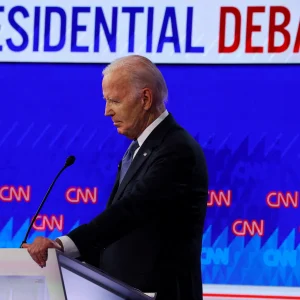In a recent New York Times poll following the highly anticipated debate between President Donald Trump and Democratic nominee Joe Biden, Trump’s lead over Biden has expanded. The poll revealed that a majority of voters found Trump to be more confident and assertive during the debate, which may have contributed to his increased popularity. Additionally, Trump’s focus on his administration’s accomplishments and promises of continued economic growth seemed to resonate with voters, particularly in key swing states.
On the other hand, Biden’s performance was criticized for appearing hesitant and lacking in specific policy proposals. This shift in voter sentiment could have significant implications for the upcoming election, as Trump’s widening lead in critical battleground states could potentially secure his re-election. However, it is important to remember that polls are just one indicator of public opinion and the true outcome of the election will ultimately be decided by the American people on Election Day.

Debate Performance Impact on Polling Numbers
The impact of debate performance on polling numbers is a topic of much discussion and analysis in the political sphere. A candidate’s ability to effectively communicate their ideas and policies during a debate can have a significant influence on how they are perceived by the public. A strong debate performance can boost a candidate’s popularity and increase their chances of gaining support from undecided voters. Conversely, a poor debate performance can damage a candidate’s image and cause their polling numbers to decline. The way in which a candidate presents themselves, their level of confidence, and their ability to articulate their positions on key issues all play a role in shaping public perception.
Additionally, the effectiveness of a candidate’s rebuttals and ability to think on their feet can also impact how they are perceived by voters. In the age of social media and instant communication, debate performances are often dissected and analyzed in real-time, further amplifying their potential impact on polling numbers. It is clear that debate performance can play a crucial role in shaping the outcome of an election and candidates must be mindful of the importance of these high-stakes events. Ultimately, a strong debate performance can serve as a powerful tool for candidates to connect with voters and sway public opinion in their favor.
Key Factors Driving Trump’s Increased Lead
There are several key factors driving Trump’s increased lead in the polls. One major factor is his ability to connect with voters on a personal level. Trump’s unique communication style and willingness to speak directly to the concerns of everyday Americans has resonated with many voters who feel disenfranchised by the political establishment. Additionally, Trump’s focus on issues such as immigration and national security has struck a chord with a significant portion of the electorate who are concerned about these issues. Another factor driving Trump’s increased lead is his strong support among certain demographic groups, such as white working-class voters and evangelical Christians.
These groups have been drawn to Trump’s promises to bring back jobs and protect traditional values. Finally, Trump’s brash and confident demeanor has also played a role in his increased lead. Some voters see Trump as a strong leader who will not be swayed by political correctness or outside influences. Overall, a combination of Trump’s ability to connect with voters, his focus on key issues, his support among certain demographic groups, and his confident demeanor have all contributed to his increased lead in the polls.
How Debate Dynamics Shaped Voter Perception
The dynamics of political debates have played a significant role in shaping voter perception throughout history. These debates serve as a platform for candidates to present their ideas, policies, and visions for the future, allowing voters to evaluate and compare their positions. The way in which candidates engage with each other during debates can influence how voters perceive their credibility, competency, and trustworthiness. For example, candidates who are able to effectively communicate their ideas, stay composed under pressure, and respond to tough questions with confidence are often viewed more favorably by voters.

Conversely, candidates who resort to personal attacks, deflection, or evasion of questions may be seen as less trustworthy or capable. Additionally, the format and structure of debates can also impact voter perception, as certain formats may favor one candidate over another based on their speaking style, charisma, or ability to connect with the audience. Overall, the dynamics of debates play a crucial role in shaping voter perception by providing a platform for candidates to showcase their strengths and weaknesses, allowing voters to make informed decisions about who they believe is the best candidate to lead.
State-Specific Trends: Analyzing New York Times Data
State-specific trends can be gleaned from analyzing New York Times data, providing valuable insights into various aspects of society. By examining patterns in news coverage and readership within specific states, researchers can identify unique cultural, economic, and political trends that shape the local landscape. For example, data may reveal varying levels of interest in certain topics or issues, such as climate change, healthcare, or education, depending on the region. Additionally, analyzing reader engagement with specific articles or topics can shed light on the priorities and concerns of residents in different states.
Furthermore, trends in news consumption and media consumption habits can offer important insights into the ways in which information is disseminated and consumed in different parts of the country. By examining data from the New York Times, researchers can gain a deeper understanding of the diverse and evolving social dynamics at play within individual states. This information can be invaluable for policymakers, businesses, and individuals seeking to better understand and engage with local communities. Ultimately, the analysis of state-specific trends in New York Times data can provide a rich and nuanced portrait of the complex and ever-changing landscape of American society.

Implications for the Upcoming Election Cycle
The upcoming election cycle is poised to have significant implications for the future of our country. With the political landscape more divided than ever, it is crucial that voters carefully consider the candidates and their platforms before heading to the polls. The decisions made in this election will shape the direction of our nation for years to come, impacting everything from economic policies to social issues. As candidates vie for the support of the American people, it is important for voters to critically evaluate the promises and proposals put forth by each contender. This election cycle will not only determine who holds power in government, but also the values and priorities that will guide our country moving forward.
It is imperative that voters educate themselves on the issues at stake and make informed decisions at the ballot box. The consequences of this election will be far-reaching, affecting not only the current generation but also future generations. The choices made in this election will set the course for our nation’s future, determining the path we will take on issues ranging from healthcare to climate change. As the campaign season heats up, it is more important than ever for voters to engage with the political process and make their voices heard. The decisions made in this election will have lasting implications for our country, shaping the policies and direction of our government for years to come. It is up to each and every voter to carefully consider the candidates and their platforms, and to cast their vote with the future of our nation in mind.
